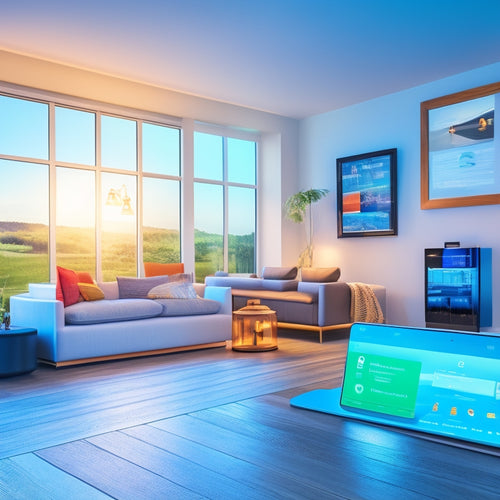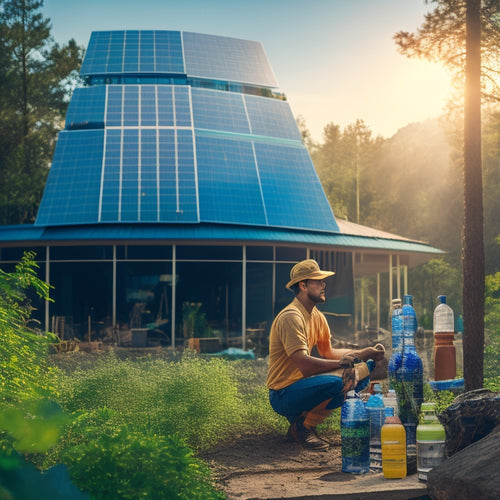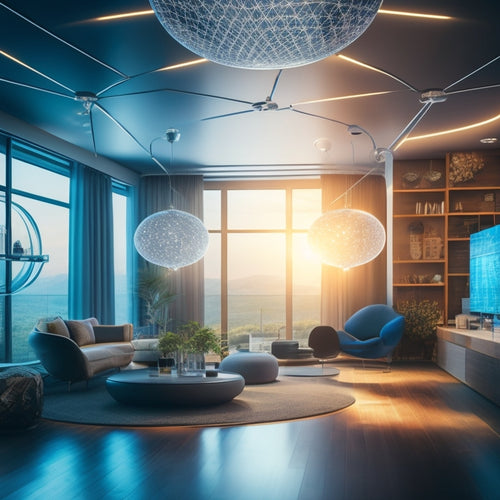
Why Automated Blinds Cut Your Home's Carbon Emissions
Share
By installing automated blinds, you can reduce your home's carbon emissions by optimizing natural light and heat usage, minimizing artificial lighting and heating needs. Automated blinds regulate natural light entry, maintaining consistent indoor temperatures, and reduce reliance on HVAC systems, leading to lower energy consumption and carbon emissions. They can also minimize heat loss in winter and block heat gain in summer, optimizing temperature control. By implementing these energy-efficient strategies, you can decrease your energy bills and carbon footprint. Now, uncover the specific techniques and technologies that can maximize these benefits in your home.
Key Takeaways
- Automated blinds optimize natural light and heat, reducing artificial lighting and heating needs, thereby cutting carbon emissions.
- By minimizing heat loss in winter and heat gain in summer, automated blinds reduce reliance on HVAC systems and lower energy consumption.
- Smart integration of automated blinds with solar energy solutions and other home devices enhances overall energy efficiency and reduces carbon footprint.
- Sensors and automated schedules allow for precise temperature control, minimizing energy waste and promoting sustainable living.
- By maximizing natural light and minimizing artificial lighting needs, automated blinds decrease energy consumption and contribute to a reduced carbon footprint.
Energy Efficiency Through Automation
You're likely aware that your home's energy consumption has a significant impact on the environment, and you're probably keen to reduce your carbon footprint.
One effective way to do so is by leveraging automation in your home. Automated blinds, for instance, can optimize natural light and heat, reducing the need for artificial lighting and heating.
By integrating solar energy solutions, such as high-efficiency solar panels with anti-reflective coating renewable energy sources, you can further minimize your reliance on fossil fuels and lower your carbon footprint.
With smart home integration, you can seamlessly control these blinds using user-friendly controls, adjusting them to suit your schedule and preferences.
Reduced Heating and Cooling Needs
You'll find that automated blinds can greatly reduce your heating and cooling needs by minimizing heat loss in the winter and blocking heat gain in the summer. By doing so, you'll optimize your temperature control and create a more comfortable indoor environment.
Additionally, incorporating solar powered EV charging systems can further reduce your reliance on traditional energy sources and lower your overall carbon footprint.
Furthermore, with the rising trend of renewable energy solutions in transportation, it's crucial to reflect on the benefits of sustainable installations. This is achieved through winter heat loss reduction, summer heat gain blocking, and optimized temperature control, all of which contribute to a substantial decrease in energy consumption.
Winter Heat Loss Reduction
During the winter months, heat loss through windows can account for up to 30% of a building's total heat loss, resulting in increased energy consumption and higher utility bills. You can reduce this heat loss by installing thermal curtains or blinds, which act as an extra layer of insulation.
Additionally, consider making insulation improvements, conducting energy audits, and preventing drafts through window seals and weatherproofing solutions.
Moreover, incorporating renewable energy solutions, such as solar panels or wind energy, can also reduce your reliance on fossil fuels and lower your carbon emissions.
By implementing hybrid electric solutions, you can also improve fuel efficiency and reduce emissions.
Proper building orientation, thermal mass, and glazing options can also help minimize heat loss.
By integrating these solutions with your HVAC system, you can reduce your reliance on heating and lower your carbon emissions.
Summer Heat Gain Blocking
Summer heat gain through windows can account for up to 76% of a building's total heat gain, leading to increased energy consumption and higher utility bills.
Implementing time-of-use rate strategies can help reduce energy costs by optimizing energy usage during off-peak hours.
By installing automated blinds, you can effectively block out solar heat during the summer months. The right blind materials can reflect or absorb solar radiation, preventing it from entering your home.
This reduces the need for air conditioning, which is a significant contributor to your home's carbon emissions.
With automated blinds, you can optimize the angle and position of your blinds to maximize solar heat blocking.
Optimized Temperature Control
The precise control of temperature fluctuations within a building is essential for minimizing heating and cooling needs.
With automated blinds, you can achieve optimized temperature control, reducing your reliance on HVAC systems. By regulating the amount of natural light entering your home, you can maintain a consistent indoor temperature, reducing the need for heating and cooling. This, in turn, decreases your energy consumption and carbon emissions.
Additionally, incorporating solar-powered charging solutions can further reduce your carbon footprint, especially in rural areas. By leveraging energy storage systems, you can optimize charging efficiency and enhance grid resiliency.
Automated blinds enable you to fine-tune temperature regulation, ensuring indoor comfort while minimizing energy waste. By automating your blinds, you can create a comfortable living space while reducing your environmental footprint.
Natural Light Optimization Techniques
How effectively do you employ natural light in your space? By leveraging natural light optimization techniques, you can reduce your reliance on artificial lighting and cut your home's carbon emissions.
To maximize natural light, consider the following strategies:
-
Light diffusion: Use sheer curtains or blinds to scatter natural light, reducing harsh glare and creating a more even illumination.
-
Glare reduction: Install automated blinds with built-in glare reduction features, such as angled slats or specialized coatings, to minimize eye strain and discomfort.
-
Optimal window placement: Strategically position windows to capture natural light during peak hours, reducing the need for artificial lighting.
- Seasonal adjustments: Adjust your blinds seasonally to maximize natural light during winter months and minimize it during summer months, reducing the need for heating and cooling.
Smart Blinds for Energy Savings
By incorporating natural light optimization techniques, you've taken the first step towards reducing your carbon footprint.
Now, it's time to contemplate smart blinds that can further enhance energy savings. These smart window solutions come equipped with energy monitoring capabilities, allowing you to track and adjust your energy usage.
Automated schedules and remote control features enable you to customize your blinds' operation according to your user preferences. With smart integration, you can seamlessly connect your blinds to other smart devices in your home.
Furthermore, eco-friendly materials and design aesthetics guarantee a stylish, sustainable solution.
With various installation options and cost benefits, smart blinds are a savvy investment for the modern homeowner seeking freedom from high energy bills.
Automated Shading for Insulation
In tandem with natural light optimization, automated shading for insulation plays an essential part in reducing heat gain during summer and heat loss during winter.
By integrating automated shading into your home's design, you can greatly improve its thermal performance. This is achieved through the strategic use of shading materials that block or filter sunlight, reducing the need for heating and cooling.
Here are four key benefits of automated shading for insulation:
-
Optimized energy usage: Automated shading helps reduce your energy consumption, leading to cost savings and a smaller carbon footprint.
-
Enhanced user comfort: By maintaining a consistent indoor temperature, you'll enjoy improved comfort and a sense of freedom in your own home.
-
Smart design integration: Automated shading can be seamlessly integrated into your home's design, ensuring a sleek and modern aesthetic.
- Improved energy audit results: With automated shading, you'll see better results in your energy audit, thanks to the reduced energy consumption and improved thermal performance.
Carbon Footprint Reduction Strategies
You can reduce your carbon footprint by implementing strategies that minimize energy consumption and optimize natural light usage.
By doing so, you'll not only decrease your reliance on artificial lighting but also lower your energy bills.
Effective carbon footprint reduction strategies involve striking a balance between reducing energy consumption and maximizing natural light utilization.
Reduce Energy Consumption
As the world shifts towards sustainable living, reducing energy consumption has become an essential aspect of minimizing our carbon footprint. By automating your blinds, you can make a significant impact on reducing your energy consumption. Here's how:
-
Energy monitoring: Automated blinds can be integrated with energy monitoring systems to track your energy usage in real-time, helping you identify areas of improvement.
-
Smart home optimization: Automated blinds can be programmed to work in tandem with your smart home system to optimize energy usage based on your schedule and preferences.
-
Heating and cooling reduction: By regulating the amount of sunlight that enters your home, automated blinds can reduce the need for heating and cooling, resulting in significant energy savings.
- Peak hour management: Automated blinds can be programmed to adjust during peak energy usage hours, reducing the strain on the grid and minimizing your carbon footprint.
Optimize Natural Light
By utilizing natural light, you can greatly reduce your reliance on artificial lighting, which consumes a substantial amount of energy and contributes to your carbon footprint.
Automated blinds enable effective sunlight management, allowing you to control the amount of natural light entering your home. This, in turn, reduces the need for artificial lighting, thereby decreasing energy consumption.
Additionally, automated blinds facilitate light diffusion, dispersing natural light evenly throughout your home. This not only enhances the ambiance but also reduces the number of light fixtures required, resulting in a significant decrease in energy consumption and, subsequently, your carbon footprint.
How Sensors Optimize Energy Use
Sensors strategically integrated into automated blinds continuously monitor ambient light levels, temperature, and humidity, generating essential data that optimizes energy use in buildings.
This data is then used to adjust the blinds' position, allowing you to make the most of natural light and heat while minimizing the need for artificial lighting and heating or cooling.
By leveraging sensor technology, you can:
-
Reduce energy consumption: By optimizing energy use, you'll lower your energy bills and carbon emissions.
-
Improve energy monitoring: Real-time data provides observations into your energy usage, helping you identify areas for improvement.
-
Enhance comfort: Automated blinds guarantee a consistent and comfortable indoor climate, regardless of the weather outside.
- Increase energy independence: By reducing your reliance on artificial lighting and HVAC systems, you'll enjoy greater freedom from the grid.
Maximizing Daylight in Winter
You've optimized energy use in your building by leveraging sensor technology in automated blinds. Now, it's time to maximize daylight in winter. During this season, the sun is lower in the sky, resulting in shallower daylight angles. To make the most of natural light, your automated blinds can make seasonal adjustments to allow more daylight in.
| Season | Blind Tilt |
|---|---|
| Winter | 30-40° |
| Spring/Autumn | 20-30° |
| Summer | 0-20° |
Minimizing Heat Gain in Summer
During the summer months, the sun's higher angle in the sky means your building receives more direct sunlight, resulting in increased heat gain. This can lead to higher energy bills and a strain on your air conditioning system.
To combat this, you can implement effective shading strategies to reduce solar heat and improve thermal performance.
Here are some ways automated blinds can help:
-
Optimized Shading: Automated blinds can be programmed to adjust according to the sun's position, minimizing heat gain while still allowing for daylight management.
-
Smart Window Treatments: By integrating with smart technology, automated blinds can learn your schedule and preferences to optimize heat reduction and energy budgets.
-
Passive Design: Automated blinds can be used to enhance passive design principles, reducing the need for air conditioning and promoting a more sustainable living space.
- Energy Efficiency: By minimizing heat gain, automated blinds can help reduce your energy consumption and lower your carbon emissions, giving you more freedom to live life on your own terms.
Frequently Asked Questions
Can I Install Automated Blinds in My Existing Home?
You can install automated blinds in your existing home using various installation options, such as retrofitting, replacing existing blinds, or integrating with smart home systems, to reap energy savings and enhance your living space.
Do Automated Blinds Work With All Types of Windows?
You can install automated blinds on most window types, including double-hung, casement, and skylights, to enhance energy efficiency, and they're designed to optimize natural light and heat control, regardless of your window's style or size.
How Long Do Automated Blind Batteries Typically Last?
You'll be surprised to know that some automated blinds can run for 5 years on a single set of batteries! Typically, they last between 2-5 years, depending on usage and battery maintenance, which also supports energy efficiency in your daily life.
Can I Control My Automated Blinds With Voice Commands?
You can control your automated blinds with voice commands, enjoying seamless voice control benefits, especially with smart home integration, allowing you to effortlessly adjust lighting and ambiance with just a few words, granting you ultimate freedom and convenience.
Are Automated Blinds Compatible With Smart Home Systems?
As you open the doors to your smart home, you'll find automated blinds harmoniously integrating with your system, much like a conductor leading an orchestra, ensuring seamless energy efficiency and smart integration, giving you the freedom to control your ambiance with ease.
Related Posts
-

10 Best WiFi Outlets for Tracking Home Energy Usage
You can optimize your home's energy usage with the right WiFi outlets, which provide real-time monitoring and control...
-

What Tax Deductions Apply to Sustainable Building Materials?
You can claim various tax deductions for sustainable building materials, thanks to over 40 federal tax incentives sup...
-

7 Blockchain Tools for Home Energy Management
You can utilize blockchain technology to optimize your home's energy management through innovative solutions like blo...


